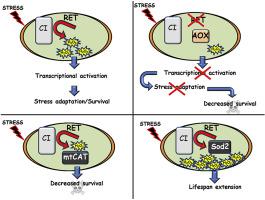Redox Biology ( IF 11.4 ) Pub Date : 2020-02-07 , DOI: 10.1016/j.redox.2020.101450 Filippo Scialò 1 , Ashwin Sriram 2 , Rhoda Stefanatos 2 , Ruth V Spriggs 3 , Samantha H Y Loh 3 , L Miguel Martins 3 , Alberto Sanz 1

|
Reactive Oxygen Species (ROS) are essential cellular messengers required for cellular homeostasis and regulate the lifespan of several animal species. The main site of ROS production is the mitochondrion, and within it, respiratory complex I (CI) is the main ROS generator. ROS produced by CI trigger several physiological responses that are essential for the survival of neurons, cardiomyocytes and macrophages. Here, we show that CI produces ROS when electrons flow in either the forward (Forward Electron Transport, FET) or reverse direction (Reverse Electron Transport, RET). We demonstrate that ROS production via RET (ROS-RET) is activated under thermal stress conditions and that interruption of ROS-RET production, through ectopic expression of the alternative oxidase AOX, attenuates the activation of pro-survival pathways in response to stress. Accordingly, we find that both suppressing ROS-RET signalling or decreasing levels of mitochondrial H2O2 by overexpressing mitochondrial catalase (mtCAT), reduces survival dramatically in flies under stress. Our results uncover a specific ROS signalling pathway where hydrogen peroxide (H2O2) generated by CI via RET is required to activate adaptive mechanisms, maximising survival under stress conditions.
中文翻译:

线粒体复合物 I 衍生的 ROS 调节黑腹果蝇的应激适应。
活性氧 (ROS) 是细胞稳态所需的重要细胞信使,可调节多种动物物种的寿命。ROS 产生的主要场所是线粒体,在线粒体内,呼吸复合物 I (CI) 是主要的 ROS 发生器。CI 产生的 ROS 触发了几种对神经元、心肌细胞和巨噬细胞的生存至关重要的生理反应。在这里,我们表明当电子以正向(正向电子传输,FET)或反向(反向电子传输,RET)流动时,CI 会产生 ROS。我们证明了通过 RET (ROS-RET) 产生的 ROS 在热应激条件下被激活,并且通过替代氧化酶 AOX 的异位表达中断 ROS-RET 产生,减弱了响应压力的促生存途径的激活。2 O 2通过过表达线粒体过氧化氢酶 (mtCAT),显着降低了压力下果蝇的存活率。我们的研究结果揭示了一个特定的 ROS 信号通路,其中 CI 通过 RET 产生的过氧化氢 (H 2 O 2 ) 需要激活适应性机制,从而最大限度地提高压力条件下的存活率。



























 京公网安备 11010802027423号
京公网安备 11010802027423号